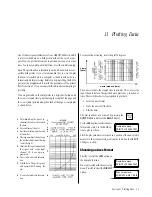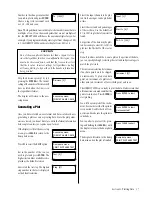
22 Section 6: Setting Up Alarms
You can use the
SCAN
keys to review or edit the coefficients individu-
ally. Press
CLEAR
to return to the transducer menu.
The dual type input uses ten co-
efficients to convert the trans-
ducer output to meaningful
readings. The coefficients may be
found on the cable reel or with
accompanying documentation.
Coefficients C0, C1, and C2 are used to compute temperature in de-
grees Celsius using the following formula:
T = C0 + X · C1/10 + X
2
· C2/100
where
T =
Temperature in degrees Celsius
X =
Normalized transducer temperature
Coefficients C3-C5 are used to calculate the primary value (e.g., con-
ductivity, pH):
V = C3 + Y · C4/10 + Y2 · C5/100
where
V =
Measured value
Y =
Normalized transducer value
The primary value is corrected for temperature variations (V
c
) as
follows:
C6 + V
×
C7/1000
1 + C8(T-25)/1000
V
c
= ——————— + C9
Battery Life Tip
Dual-mode transducers consume considerably more
power than their single-function counterparts. Minimiz-
ing the number of reads will help to extend battery life, as
will increasing the sample interval. Select a sample rate
that gives good data quality without recording excessive
or redundant points.
If you wish to display uncompensated primary values, set coefficient
C8 to zero. Refer to the specific dual-mode transducer manual for
other options you may have.
Press
READ
to take a transducer
reading and verify proper connection
and operation of the transducer.
Readings on a dual-mode transducer
require about five seconds.
The temperature and primary values
are displayed simultaneously.
Reminder
: Due to the time required to read a dual-mode trans-
ducer, all dual-mode data recorded during the first ten minutes of a
test in the log sample mode will be meaningless and should be ig-
nored.
Input 4: Dual
READ I.D. COEF.
Input 4: Dual
Busy...
Input 4: Dual
20.60
o
C
7.600
6 Setting Up Alarms
The alarm function on the HERMIT 2000 adds two powerful capa-
bilities to your tests.
• You can synchronize the start of a test to the occurrence of an
alarm event.
• You can synchronize other field equipment, such as an auto-
matic sampler, with alarms detected by the HERMIT 2000.
If your test does not require either of these features, you may skip
this section and return to it at a later time.
Alarm Operation
Each input on the HERMIT 2000 has an independently program-
mable alarm with a high and low limit setting. Since there is only
one contact output for a high alarm and one for a low alarm, the
alarms for each input are “or’ed” together. Thus a high alarm on
input 1 or a high alarm on input 2 will activate the high alarm
contact. Similarly a low alarm on an input or any other input will
activate the low alarm contact.
Inputs are checked against their alarm limits at each data point
while a test is running. If the high or low alarm contact is activated,
it will remain activated even if the instrument is asleep.
Note:
When the HERMIT 2000 is programmed in the log sample mode,
alarms are not checked during the first ten minutes of the test.














































